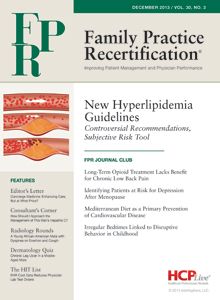Publication
Article
Family Practice Recertification
Long-Term Opioid Treatment Lacks Benefit for Chronic Low Back Pain
Author(s):
While some low- to moderate-level evidence exists for the short-term use of opioids in low back pain, this well-done systematic review found no evidence to support their long-term use.
Frank J. Domino, MD
Review
Chaparro LE, Furlan AD, Deshpande A, Mailis-Gagnon A, Atlas S, Turk DC. Opioids compared to placebo or other treatments for chronic low-back pain. Cochrane Database Syst Rev. 2013 Aug 27;8:CD004959. http://onlinelibrary.wiley.com/doi/10.1002/14651858.CD004959.pub4/abstract.
Study Methods
This was a systematic review of the medical literature from 2006 to 2012 that assessed the use of opioids, either as monotherapy or in combination with other therapies. The study included randomized controlled trials (RCTs) that compared non-injectable opioids to placebo or other treatments, though RCTs that only compared different opioids to each other were excluded.
Patient Demographics
The patient population examined in this study was comprised of adults with chronic low back pain for at least 4 weeks in duration.
Results and Outcomes
Fifteen RCTs with a total of 5,540 participants were included in the systematic review, which found:
- In 5 RCTs with a total of 1,378 participants, tramadol was found to be more effective than placebo for short-term pain (standardized mean difference [SMD] -0.55, 95% confidence interval [CI] -0.66 to -0.44; low-quality evidence) and function (SMD -0.18, 95% CI -0.29 to -0.07; moderate-quality evidence). However, 1 RCT with 1,583 participants demonstrated that tramadol might make little difference compared to celecoxib for pain relief (risk ratio [RR] 0.82, 95% CI 0.76 to 0.90; very low-quality evidence).
- Two RCTs with 653 participants total found transdermal buprenorphine made little difference compared to placebo for pain (SMD -2.47, 95% CI - 2.69 to -2.25; very low-quality evidence), but no difference for function (SMD-0.14, 95% CI -0.53 to 0.25; very low-quality evidence).
- In 6 RCTs with a total of 1,887 participants, morphine, hydromorphone, oxycodone, oxymorphone, and tapentadol were all better than placebo for only short-term pain (SMD -0.43, 95%CI -0.52 to -0.33; moderate-quality evidence) and function (SMD -0.26, 95% CI -0.37 to -0.15; moderate-quality evidence).
- Two RCTs with 272 participants total found no difference between opioids and antidepressants for either pain (SMD 0.21, 95% CI -0.03 to 0.45; very low-quality evidence) or function (SMD -0.11, 95% CI -0.63 to 0.42; very low-quality evidence).
All RCTs included in the review had high dropout rates, short durations, and limited interpretability of functional improvement. They did not report any serious adverse effects, risks like addiction or overdose, or complications such as sleep apnea, opioid-induced hyperalgesia, or hypogonadism. In general, the effect sizes were medium for pain and small for function.
Conclusion
There is some very low- to moderate-quality evidence for only the short-term efficacy of opioids for pain and function in low back pain compared to placebo, but this study tells us there is no data to support their use for chronic low back pain. Additionally, there are very few RCTs that compared opioids to non-steroidal anti-inflammatory drugs (NSAIDs) or antidepressants.
The authors advise “the initiation of a trial of opioids for long-term management should be done with “extreme caution,” and only after a comprehensive assessment of potential risks. They further state “there are no placebo [controlled] RCTs supporting the effectiveness and safety of long-term opioid therapy for treatment of” chronic low back pain.
Commentary
This well-done systematic review evaluated data on the efficacy of the long-term use of opioids for chronic, non-malignant pain and ultimately found none. Some low- to moderate-level evidence exists for the short-term use of opioids, but there was no evidence for their long-term use.
Due to a variety of forces — including assertive marketing and our own desire to provide relief for those in our care — the utilization of long-term opioid agents for chronic, non-malignant pain and chronic low back pain, in particular, has skyrocketed in the last 15 years. Running parallel to rising prescription use are complication rates, the most concerning of which is accidental death.
According to the US Centers for Disease Control and Prevention (CDC), accidental prescription overdose is the leading cause of death in the US — even more than illicit drugs, motor vehicle accidents, and violence combined. These are not suicide cases, but patients taking extra doses of mediations and/or combining their prescribed medications inappropriately and suffering an adverse outcome.
If chronic opioids do not provide a benefit, then what does improve outcomes for long-term chronic pain? The best evidence recommends compassion and cognitive behavioral therapy, as well as the use of low-dose antidepressants and some anti-seizure agents — all with the goal of returning the patient to a functional status, despite his or her disability.
An update of another systematic review of chronic opioids for neuropathic pain was also released this year, and the findings were similar.1 Some evidence supports the use of short-term opioids for neuropathic pain, but there is no unbiased data to support chronic opioid use in the long-term.
So, why do patients seek opioids if they provide no pain relief? Experts infer that the benefit of opioids comes from the relief of the psychological complications of chronic pain. Opioids provide this benefit poorly, and their use results in dependence and the fear of withdrawal. Should doses be missed and the patient experiences withdrawal symptoms, the symptoms’ negative reinforcement compounds the patient’s desire for continuing these medications.
The bottom line is providers should only initiate opioids for chronic non-malignant pain after the patient has returned to function. Clinicians should also provide clear warning of the dangers of the misuse of these medications. If your patients are already taking chronic opioids, then provide a comprehensive approach to their pain, educate them about the lack of pain relief benefit from these agents, and wean them off.
References
1. McNicol ED, Midbari A, Eisenberg E. Opioids for neuropathic pain. Cochrane Database of Syst Rev. 2013 Aug 29;8:CD006146. http://www.ncbi.nlm.nih.gov/pubmed/23986501.
About the Author
Frank J. Domino, MD, is Professor and Pre-Doctoral Education Director for the Department of Family Medicine and Community Health at the University of Massachusetts Medical School in Worcester, MA. Domino is Editor-in-Chief of the 5-Minute Clinical Consult series (Lippincott Williams & Wilkins). Additionally, he is Co-Author and Editor of the Epocrates LAB database, and author and editor to the MedPearls smartphone app. He presents nationally for the American Academy of Family Medicine and serves as the Family Physician Representative to the Harvard Medical School’s Continuing Education Committee.



























